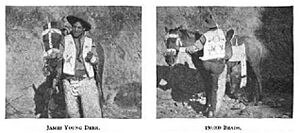James Young Deer facts for kids
James Young Deer (born James Young Johnson on April 1, 1876) was a very important person in early Hollywood. He was an actor, director, writer, and producer. Many believe he was the first Native American filmmaker in Hollywood.
Young Deer worked closely with his wife, Lillian St. Cyr, who was from the Winnebago Tribe. Together, they were a powerful team in making short Western films during the early silent film era. Their movies, and some others from that time, were special because they showed Native Americans in a good way.
There were some questions later about Young Deer's background. While he was identified as Winnebago in early film papers, his family actually came from the Nanticoke people of Delaware.
Contents
Early Life and Adventures
James Young Deer was born in Washington, D.C. His parents were George Durham Johnson and Emma Margaret Young.
He joined the U.S. Navy in 1898 for three years, during the Spanish–American War. However, he didn't enjoy his time in the Navy.
Later, newspapers wrote that he performed as a cowboy. They said he rode with famous shows like the Barnum and Bailey Circus and the Miller Brothers' 101 Ranch Wild West Show.
Marriage and Partnership
James Young Deer met actress Lillian St. Cyr in Washington, D.C. They got married on April 9, 1906. Lillian was known by her stage name, Red Wing.
Red Wing was born on the Winnebago Reservation near Omaha. She was a member of the Winnebago Tribe of Nebraska. She became famous for her main role in the 1914 film The Squaw Man.
A Career in Early Film
Young Deer started acting in 1909. He appeared in many short Western films in New York. He worked for several film companies, including Kalem, Lubin, Vitagraph, and Biograph. He also worked for one of the first independent film companies, the New York Motion Picture Company.
In 1910, Young Deer was hired to direct films for Pathé Frères. This French studio in Jersey City wanted their Western movies to look more real. So, they sent Young Deer to Los Angeles to make films about Native Americans. His wife, Red Wing, often acted in his movies. Young Deer eventually managed Pathé's West Coast Studio operations.
He acted in, wrote, or directed about 150 silent movies at Pathé's studio.
Impact of His Work
Around 1910, Westerns were very popular, making up one-fifth of all American films. In these early years, Native Americans were usually shown in a good way. Directors often hired Native Americans as actors. Film historian William K. Everson noted that during this time, Native Americans became seen as symbols of honesty and strength.
Young Deer's films were special because they avoided common Western stereotypes. They didn't show hostile Native American warriors or wagon train attacks. Other studios, like Kalem, also showed Native Americans in a positive light. The success of Young Deer and St. Cyr was partly because she was educated and understood Native American culture. Also, the film industry back then was open to new ideas and experiments.
Later Years and Legacy
After 1913, Young Deer traveled overseas. He worked in Great Britain, making thrillers in London in 1914. These included The Queen of the London Counterfeiters and The Black Cross Gang. Some writers say he made documentaries in France during World War I, but this has not been confirmed.
When he returned from Great Britain in 1914, Young Deer found it hard to get work. Western films were less popular for a while. He was said to have run an acting school in San Francisco. In the 1930s, he sometimes worked as a second-unit director on smaller, independent films and serials.
James Young Deer passed away in New York City on April 6, 1946. He was buried as James Young Johnson, a veteran of the Spanish–American War.
Many of his early films are now lost. However, in 2008, the Library of Congress added White Fawn's Devotion to its National Film Registry. This is one of Young Deer's few surviving films.
Films
Director
- Lieutenant Daring RN and the Water Rats (1924)
- The Stranger (1920/I) (as James Youngdeer)
- Who Laughs Last (1920)
- The Savage (1913)
- The Unwilling Bride (1912)
- The Squaw Man's Sweetheart (1912)
- Red Deer's Devotion (1911)
- The Yaqui Girl (1910)
- Cowboy Justice (1910)
- An Indian's Gratitude (1910)
- A Cheyenne Brave (1910)
- The Red Girl and the Child (1910)
- Under Both Flags (1910)
- White Fawn's Devotion: A Play Acted by a Tribe of Red Indians in America (1910) (uncredited)
- Red Wing's Gratitude (1909)
- For Her Sale; or, Two Sailors and a Girl (1909)
- The Falling Arrow (1909)
Actor
- The Man of Courage (1922) .... Aquila
- Under Handicap (1917) (as James Youngdeer) .... Lonesome Pete
- Against Heavy Odds (1914)
- The Unwilling Bride (1912)
- Little Dove's Romance (1911)
- Red Deer's Devotion (1911)
- Young Deer's Return (1910) .... Young Deer
- The Red Girl and the Child (1910)
- The Indian and the Cowgirl (1910)
- The Cowboy and the Schoolmarm (1910)
- Young Deer's Gratitude (1910) .... Young Deer
- The Ten of Spades; or, A Western Raffle (1910)
- Young Deer's Bravery (1909) .... Young Deer
- Red Wing's Gratitude (1909)
- The Mended Lute (1909) .... Indian
- The True Heart of an Indian (1909) … aka A True Indian's Heart (USA)
Writer
- Lieutenant Daring RN and the Water Rats (1924) (writer)
- Neck and Noose (1919) (story) (as Jim Youngdeer)
- White Fawn's Devotion: A Play Acted by a Tribe of Red Indians in America (1910) (uncredited)


